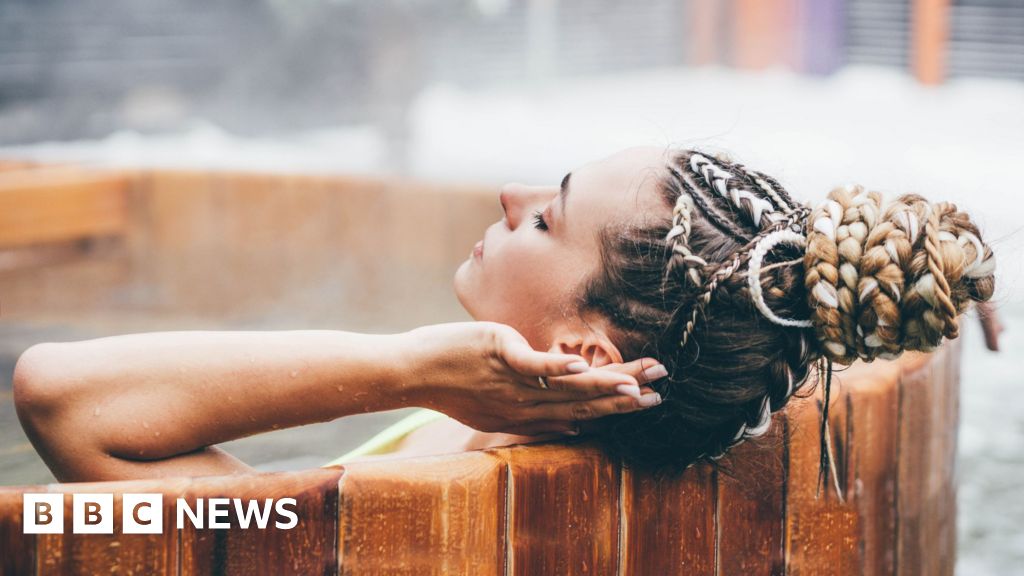image source, Getty Images
- the author, Christine Ro
- role, Technology Reporter
Some people give Severin Borenstein a hard time about having a hot tub.
“In general, the criticism of having a hot tub is that it’s a waste of energy,” he says.
The main reason for such high energy use is the heating, which generally runs even on days when the hot tub is not in use, to keep the water from getting too cold.
Because Prof Borenstein researches energy economics at the Haas School of Business, at the University of California, Berkeley, he was able to crunch the numbers for his family.
He and his wife use their hot tub regularly, about five times a week.
“To keep the tub hot every day, on average I would have to heat it for about 30 minutes a day, to compensate for the heat loss,” he explains. The hot tub is filtered for about six hours a day, and is emptied and refilled about three times a year.
The hot tub’s energy use is approximately 18% of his household’s electricity use.
Prof Borenstein calculated that running a hot tub for a year creates slightly less greenhouse gas emissions than a one-way flight between Boston and London.
That’s significant and has prompted some to call hot tubs “energy hogs,” along with hot tubs, swimming pools, and second refrigerators.
image source, Candy for the weekend
There are measures that can make pigs a little less greedy.
One factor is how a hot tub is powered.
Hot tubs usually come with their own electric heaters, so using a green energy source will cut your carbon dioxide footprint.
Those heaters can also be combined with solar water heating, to reduce the need for electricity.
However, for those installing hot tubs in their homes, this can be an extra level of complexity.
For retail customers, “simplicity is key,” says Karl Rowntree, technical director for UK hot tub manufacturer RotoSpa.
Holiday parks are more open to alternative heating systems, including solar and biomass boilers (which can run on wood pellets or even coffee grounds) and heat pumps.
Rowntree says an air source heat pump can cut energy costs by up to 75%, and can pay for itself within three years.
Other factors include how well the tub is insulated and covered to reduce heat loss; how big it is, which affects the amount of water that needs to be heated; and temperature settings.
Mr Rowntree says energy efficiency features in the control system can also help. He uses a sleep timer in his bathtub that he sets to sleep mode between 11am and 7am.
Even though it cools overnight, it’s still cheaper than leaving it overnight, he explains.
Of course, there is the option of a wood-fired hot tub. Its environmental impact will depend in part on whether the wood was from a sustainable source, but burning wood will always produce carbon dioxide.
For tour operators, another important component is the behavior of guests. At AliKats, a group of houses in the French Alps, hot tubs are very popular.
But the company, whose region experienced drought in the past two years, identified its 1,500 liter hot tubs as an area where energy and water use should be reduced.
This prompted the company to institute a new hot tub policy, where guests must pay more to use a hot tub in the summer, or if their hot tub requires a mid-week water change.
“In the winter, most guests still want to opt for the hot tub, but increasingly in the summer, more and more guests are choosing not to go,” says Al Judge, co-founder of AliKats.
As for mid-week water changes, the company believes this is easily avoided with proper usage, such as showering before getting in the tub.
Additionally, “the main thing we’ve done this year is insist on not drinking in the hot tub, and that’s allowed us to keep the water flowing a lot longer.”
Mr Judge explains: “When beer is poured into a hot tub, the yeast reacts with the water (at 37.5 degrees) and becomes unpleasant very quickly. So by banning hot tub drinking, there has been a strong positive environmental effect.”
image source, Getty Images
The hot tub market has had a rollercoaster few years. Hot tub sales increased in 2020 and 2021, during the Covid-19 pandemic. In the UK, sales fell in 2022 and 2023 due to the high cost of living and high electricity prices.
Finally, “we’re starting to see a reversal now,” says Mr. Rowntree.
He reports that RotoSpa was selling about 600 a year before Covid, 2,500 during the pandemic, and now roughly 1,000.
Much of the incremental growth comes from the popularity of hot tubs in vacation rentals. UK holiday property owners who are part of the Weekend Candy and ToWander UK networks report that having a hot tub can increase bookings by 10-20%.
However, the maintenance costs of hot tubs can be substantial. Last year, at Yorkshire’s Baxby Manor, owner Barney Smith installed three air source heat pump hot tubs, as well as solar panels and battery storage.
“Despite this, it still costs me around £100 between each shift to clean, refill and fully heat each hot tub,” reports Mr Smith.
Even with the maintenance and energy requirements, many tourism entrepreneurs believe that hot tubs are now a must.
“I’d say they’re starting to be expected as standard,” says Yasmin Wilkes, owner of Loose Reins in Dorset, where hot tubs were added in 2022 and 2023.
Back in California, Prof Borenstein says a narrow focus on energy consumption perhaps misses the “bigger picture” around hot tub use.
“There are many things we do that have an environmental impact,” he reflects.
